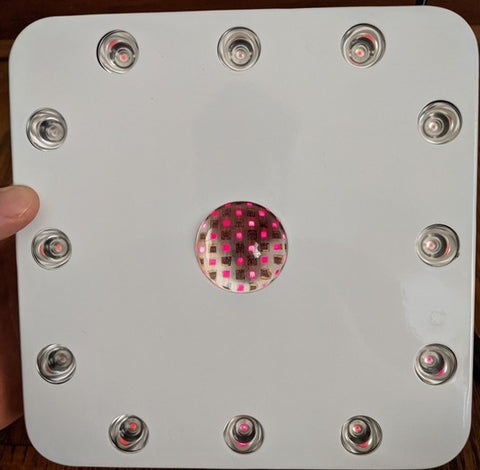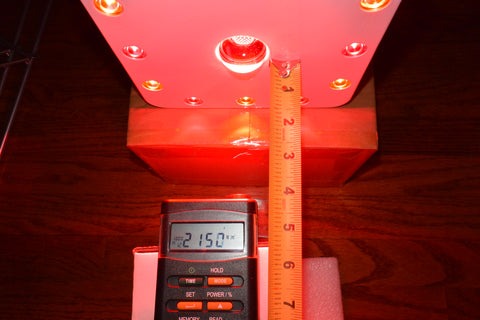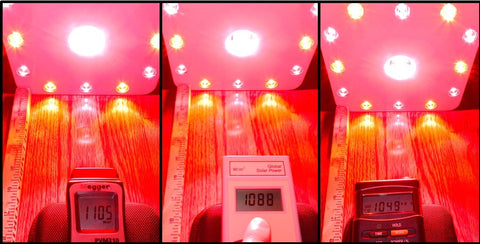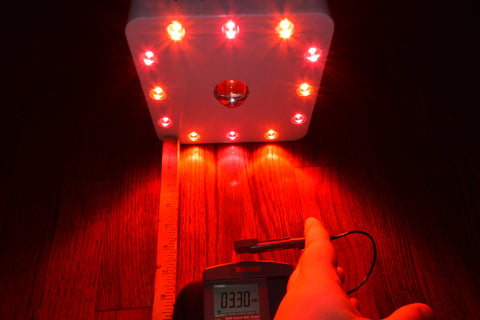
High Intensity COB Red Light Therapy Devices: The Ultimate Scam!
Red light therapy COB lights offer an interesting alternative to the typical red light "panel" that are commonly marketed. However, are they as great as they seem?
A COB light uses "Chip-on-Board" LED technology. Essentially it is many LED "chips" clustered together on a small circuit board. This offers concentrated power in a small area.

A peek inside the lens of a COB light shows the many LED chips that are crammed together.
One of the biggest gimmicks in the red light therapy is companies claiming to be higher intensity - and implying better or faster results from it. So COB lights are perfectly suited to fit this niche. Add in the false advertising of intensity with solar power meters, and these COB lights are a charlatan's dream come true.
These COB lights aren't new to the industry, in fact they might be some of the original red light therapy products that were retrofitted grow lights first marketed by the RedLightMan company in the UK. So we have to give proper credit to what potentially started this modified grow light panel industry, even though Joovv often tries to crown themselves as the first ones.
Unfortunately some companies have grasped onto the COB lights to pretend they have some sort of ingenuity. Then they used the "rated power" and solar power meters to falsely inflate their advertised power output.
Now we know most companies lie about intensity and power. There isn't much GembaRed can do about that other than educate consumers about the truth.
But when companies also feel the need to slander GembaRed by telling people our panels cost 15 dollars to make and compare thier inaccurate measurements to our professionally tested products, then we have a problem.
Now let's look at this light. This time we contacted Gerylove on Alibaba to make us this light. They seem to have good experience with making these COB lights, and insisted on changing the vent design so it doesn't conflict with one of their existing North American distributors.
https://www.alibaba.com/product-detail/Skin-treatment-led-light-therapy-machine_60806012575.html?
If we had measured any name-brand directly they would just cry foul that big-bully GembaRed is picking on them, and of course feign ignorance that we were purposely fudging the numbers. Which they seem to be pretty convincingly ignorant, whether it's an act or not... I can't tell anymore.
Gerylove says that this COB lamp is rated for 50,000 hours. That is a reasonable rating, anyone claiming to have 100,000 hours on their light would need some serious data to back that up, since the concept of a 100,000 hour LED lamp has mostly been debunked and abandoned. So that would be a big red flag for people shopping for a red light panel.
We bought two of these COB lights for $117.5 each, plus shipping. I couldn't say what price my competitors are paying for their COB lights, since only a pathological liar would just make up numbers without substantiation.
Important Safety Note!
The first thing I noticed when I plugged in the light is that all of the LEDs started to faintly glow! I have seen this defect before on cheap lights that use crappy On/Off switches or power cords.

The LEDs are glowing as soon as I plug it in, and the light switches are OFF!
I would recommend keeping these COB lights (and any lights that do this type of glow) unplugged or try using a GE Outlet Switch to eliminate the leaking current to the LEDs. I also found using a different higher-quality power cord can eliminate the issue.
Which if this isn't a safety issue, it could add unnecessary wear on the LEDs eating into any claimed 50,000 or 100,000 hour lifespan.
Consumed Power
The consumed power is often much different than the rated power, and can give customers a false sense that the power of a light is superior than another. Affecting their buying decisions if they think they are getting some special value.

Here we see the consumed power at 96.5 Watts, where some companies might claim something silly like 236 Watts which might represent the illusory "rated" power.
Where that rating seems to come from claiming 200 Watts for the middle COB, and 3 Watts each on the 12 outer LEDs. Which claiming the rated power is fine, but it is important for the consumer to compare lights is to know the actual consumed power too.
Intensity
Obviously the intensity is an important number. Most people would agree. So why doesn't anyone take it seriously and get it accurately measured? How can companies claim to have "the highest intensity" without substantiation by a professional laboratory?
COB lights are a gold-mine for scammers using solar power meters, we get a measurement of 215 mW/cm^2 at 4 inches (~10cm). Wow! That more than double the intensity of peak sunlight, and twice the intensity of the claims from leading brands! This is super easy to market and sell!
Such high intensity could be scaldingly hot radiant intensity and could quickly be an eye hazard.

But no, it is not scaldingly hot.
*Update Nov 2022*: Our 3rd party testing of this COB light shows an intensity of 154mW/cm^2 at 3 inches away. Which is very high, still much lower than a solar power meter measurement. But users should be cautious about such high intensity close to the skin.
Even Ari Whitten and Michael Hamblin have denounced solar power meters in recent interviews. So any companies or influencers still using solar power meters are either ignorant (and didn't do any proper research), or they are scammers. Unfortunately for this industry, we find most people running these companies are a dangerous combination of both.
Now lets check the 6 inches measurement since 6 inches is usually the basis of comparison for most companies.

From multiple solar power meters we get measurements at 6 inches between 105-110mW/cm^2. Which isn't anything special, most generic red light panel companies can reach this number on a solar power meter.

From our SANWA laser power meter we see the power is 33mW/0.636cm^2*.8 = 41.5mW/cm^2. Which is a good number, but still a scam of almost 3x compared to the solar power meter!
*Update Nov 2022*: Our 3rd party testing of this COB light shows an intensity of 50.1mW/cm^2 at 6 inches away. So our laser power meter is reading falsely low for high intensity measurements, but not too bad for a budget laser power meter.
The Intensity Measurements from our 3rd Party Lab for this COB Light are (with the outer LEDs turned off):
-
3 inches away: 154 mW/cm^2
-
6 inches away: 50.1 mW/cm^2
-
12 inches away: 15.5 mW/cm^2
-
24 inches away: 4.3 mW/cm^2
So you can choose which delusion you want to believe. If you think you have a panel that claims >100 mW/cm^2 at 6 inches but it is measured by a solar power meter, then that is false, plain and simple.
That said, 50.1mW/cm^2 at 6 inches is a fine intensity and can certainly be effective. Companies just need to throw away the solar power meters and embrace more accurate measurements.
Ambient Light Mode?
These smaller LEDs around the outside are offering minimal power density compared to the big COB light in the center. So I asked Gerylove to make them all visible red 630nm and 660nm (since invisible NIR would be a waste of electricity for an ambient mode), wide angle lenses, and frosted diffusers.

We only measure 3.3mW on our laser power meter at 6 inches away with the center COB off. That is 4 mW/cm^2, not a big contributor to intensity compared to the COB.
Now having an "Ambient" mode might be a trendy thing now that Joovv has added it to most of their lights. However, the key is to have soft, glare-free LEDs. That means you actually want wide-angle lenses and soft frosted diffusers. The ambient mode might be fine if you aim the panel at the wall or ceiling. Watch our video for more tips on using red ambient lights.
But overall, it is usually more practical just to use some generic light bulbs for ambient red lighting.
Coverage Area and Beam Angle:
This light is pretty neat because you can basically see the beam angle coming out of the center light. Since the intensity is much lower than advertised, it is important not to be too far away from this type of light due to the divergence of the beam.

You can see on my ruler at 6 inches away, the primary beam spread is about 7 inches wide. Which according to my trigonometry is about 60 degree beam angle! Pretty nice we can actually calculate the beam angle here!
A 7 inch diameter circle of coverage isn't huge and mostly considered a "spot" treatment in this industry. Often due to the high claims of intensity and power these COB lights might give an impression of being bigger than they seem.
EMF:
The EMF on this light is practically none at 6 inches away, which is standard for the industry. And it is fine for non-contact treatment.
Obviously one wouldn’t want to get too close to the light due to the increasing EMF, where for this type of light usually the Magnetic Field is most problematic. Here we measure 7.88 milliGauss on the front, which is actually not bad compared to other lights I have tested.
And you can’t reap the true benefits of skin contact method for this type of COB light, and much intensity will be lost due to skin reflection at further distances.

It is weird to me when companies claim "no EMF exposure" - because how do you turn it on? Reaching your hand to the back of this panel can expose you to pretty high EMF. That is why most honest companies will say "no EMF exposure at treatment distance" - which is an important qualifying statement.

Here we see a huge reading of 45 milliGauss! Usually a big offender are the power drivers and fans located on the back. So it would have been nice if the power switches were at least on the side. Of course a momentary exposure of high EMF should be fine, but it is an important note for people that are seeking honest lights that are ACTUALLY low EMF.
Flicker:
The flicker on this Gerylove COB light is very low! According to my Radex Lupin the flicker is under 1%, which is about the resolution of this tool and confirms the low flicker reading.

It is great to see companies like Gerylove, SAIDI, and Herifi on Alibaba are making great improvements to their lights and reducing flicker. Pretty soon we hope to be out-competed by safer panels coming directly from China. This way the consumer has access to factory-direct prices and low-flicker panels.
Conclusion:
The Red Light Therapy industry has opened its doors to many scammers. Companies can be completely wrong about intensity using solar power meters, make up protocols to treat or cure illnesses, completely make up information on-the-fly to seem like they are experts. Most customers won’t know any better and must trust that brands are following basic truth-in-advertising laws.
Despite all of the lies, many red light therapy products still offer tremendous benefits to people! That is why we often say the products themselves are good and fine, just the ethics and false advertising from these brands are the real problem.
At GembaRed we embrace criticism and competition. That is how we got so famous in the first place! However, it is important to call-out the lies and scams that the consumer can fall prey to. This has always been part of our mission, now we are just being more blunt about it.
Now this COB light does measure about 6-7 times more intensity than our GembaRed Rex. Not 20-40 times the intensity as one of our competitors has claimed. That is because they were using a cheap solar power meter to compare to our professional measurements. If they want to make a fair comparative analysis with accurate measurements, then that is fine. But lies and slander are illegal and will not be tolerated.
As always we hope these reviews will awaken the consumer to demand more honesty and accuracy from brands selling COB lights. If the consumer refuses to support companies that use solar power meters, then they will HAVE to stop using them and get more accurate information.
We think this is a fine COB light that Gerylove has put together. It is compact and can offer some decent spot treatment with relatively high irradiance. It is low flicker and low EMF at 6 inches away!